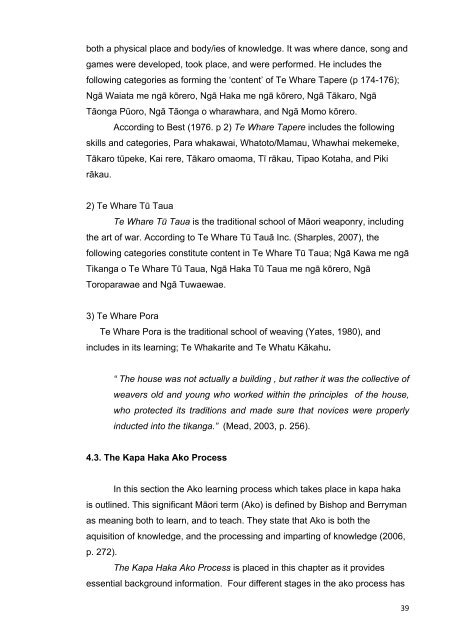Te Māoritanga WELLBEING AND IDENTITY Kapa Haka as a Vehicle
Te Māoritanga WELLBEING AND IDENTITY Kapa Haka as a Vehicle
Te Māoritanga WELLBEING AND IDENTITY Kapa Haka as a Vehicle
Create successful ePaper yourself
Turn your PDF publications into a flip-book with our unique Google optimized e-Paper software.
oth a physical place and body/ies of knowledge. It w<strong>as</strong> where dance, song and<br />
games were developed, took place, and were performed. He includes the<br />
following categories <strong>as</strong> forming the ‘content’ of <strong>Te</strong> Whare Tapere (p 174-176);<br />
Ngā Waiata me ngā kōrero, Ngā <strong>Haka</strong> me ngā kōrero, Ngā Tākaro, Ngā<br />
Tāonga Pūoro, Ngā Tāonga o wharawhara, and Ngā Momo kōrero.<br />
According to Best (1976. p 2) <strong>Te</strong> Whare Tapere includes the following<br />
skills and categories, Para whakawai, Whatoto/Mamau, Whawhai mekemeke,<br />
Tākaro tūpeke, Kai rere, Tākaro omaoma, Tī rākau, Tipao Kotaha, and Piki<br />
rākau.<br />
2) <strong>Te</strong> Whare Tū Taua<br />
<strong>Te</strong> Whare Tū Taua is the traditional school of Māori weaponry, including<br />
the art of war. According to <strong>Te</strong> Whare Tū Tauā Inc. (Sharples, 2007), the<br />
following categories constitute content in <strong>Te</strong> Whare Tū Taua; Ngā Kawa me ngā<br />
Tikanga o <strong>Te</strong> Whare Tū Taua, Ngā <strong>Haka</strong> Tū Taua me ngā kōrero, Ngā<br />
Toroparawae and Ngā Tuwaewae.<br />
3) <strong>Te</strong> Whare Pora<br />
<strong>Te</strong> Whare Pora is the traditional school of weaving (Yates, 1980), and<br />
includes in its learning; <strong>Te</strong> Whakarite and <strong>Te</strong> Whatu Kākahu.<br />
“ The house w<strong>as</strong> not actually a building , but rather it w<strong>as</strong> the collective of<br />
weavers old and young who worked within the principles of the house,<br />
who protected its traditions and made sure that novices were properly<br />
inducted into the tikanga.” (Mead, 2003, p. 256).<br />
4.3. The <strong>Kapa</strong> <strong>Haka</strong> Ako Process<br />
In this section the Ako learning process which takes place in kapa haka<br />
is outlined. This significant Māori term (Ako) is defined by Bishop and Berryman<br />
<strong>as</strong> meaning both to learn, and to teach. They state that Ako is both the<br />
aquisition of knowledge, and the processing and imparting of knowledge (2006,<br />
p. 272).<br />
The <strong>Kapa</strong> <strong>Haka</strong> Ako Process is placed in this chapter <strong>as</strong> it provides<br />
essential background information. Four different stages in the ako process h<strong>as</strong><br />
39
















